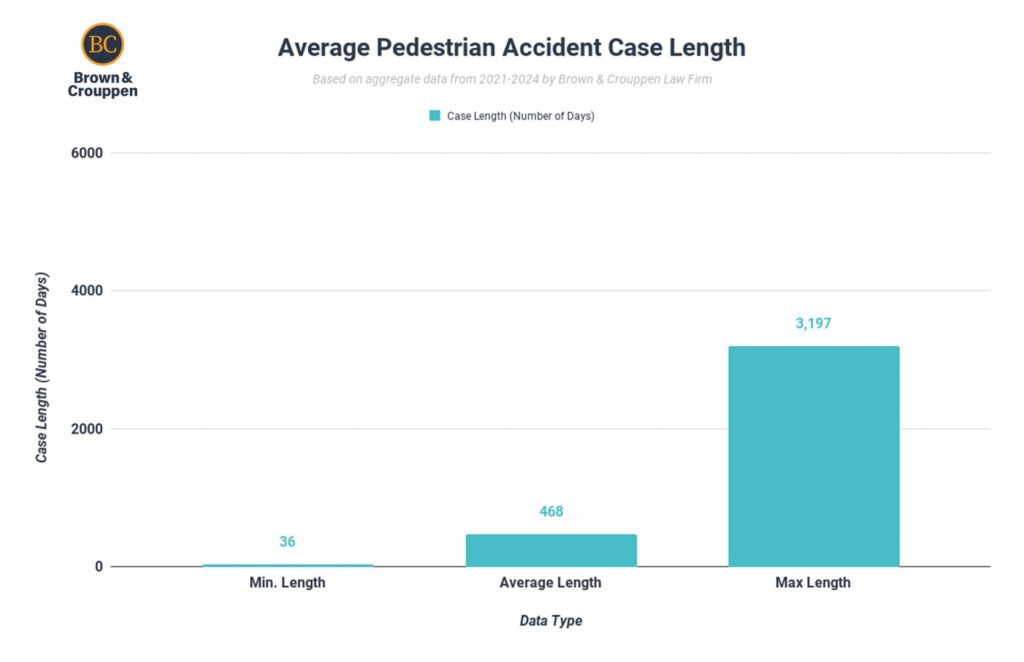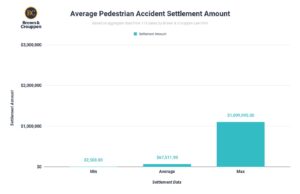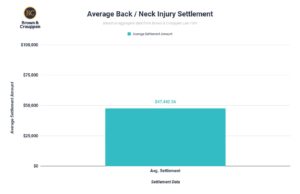Pedestrian accident cases with clear liability and non-complicated injuries often settle within 6 to 12 months after treatment is complete. Cases where individuals were hit by a car and suffered complex injuries (such as those that resulted in surgery) can take longer — often between 12 and 16 months after medical treatment is complete.
Note: This data is based on real case data derived from 150+ pedestrian accident cases between 2021 and 2024. Average case length values should not be interpreted as an estimated length or timeline for your case.
If you’ve been hit by a vehicle while legally crossing the street, you may have a claim for negligence against the driver of the vehicle. However, filing a claim will not result in immediate cash in hand. The length of time from the date of the accident to the date where you receive a check depends on several different factors. These include the length of treatment for your injuries, the time it takes to collect evidence, whether there’s insurance coverage and if the insurance company is negotiating “in good faith,” whether litigation or a trial is necessary, and the time it takes to negotiate down your medical liens and bills.
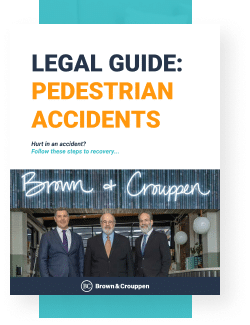
Use our guide to understand what to do after being hit by a car and key legal considerations.
Taking immediate action after a pedestrian accident—such as seeking medical care, calling the police, and gathering evidence—helps establish clear liability and injury documentation, reducing disputes that can delay a case. Prompt medical treatment creates a strong record of damages, making it harder for insurance companies to argue against compensation. Hiring an attorney and understanding what to do after being hit by a car can increase the chances of a larger and faster settlement.
Pedestrian Accident Settlement Timeline
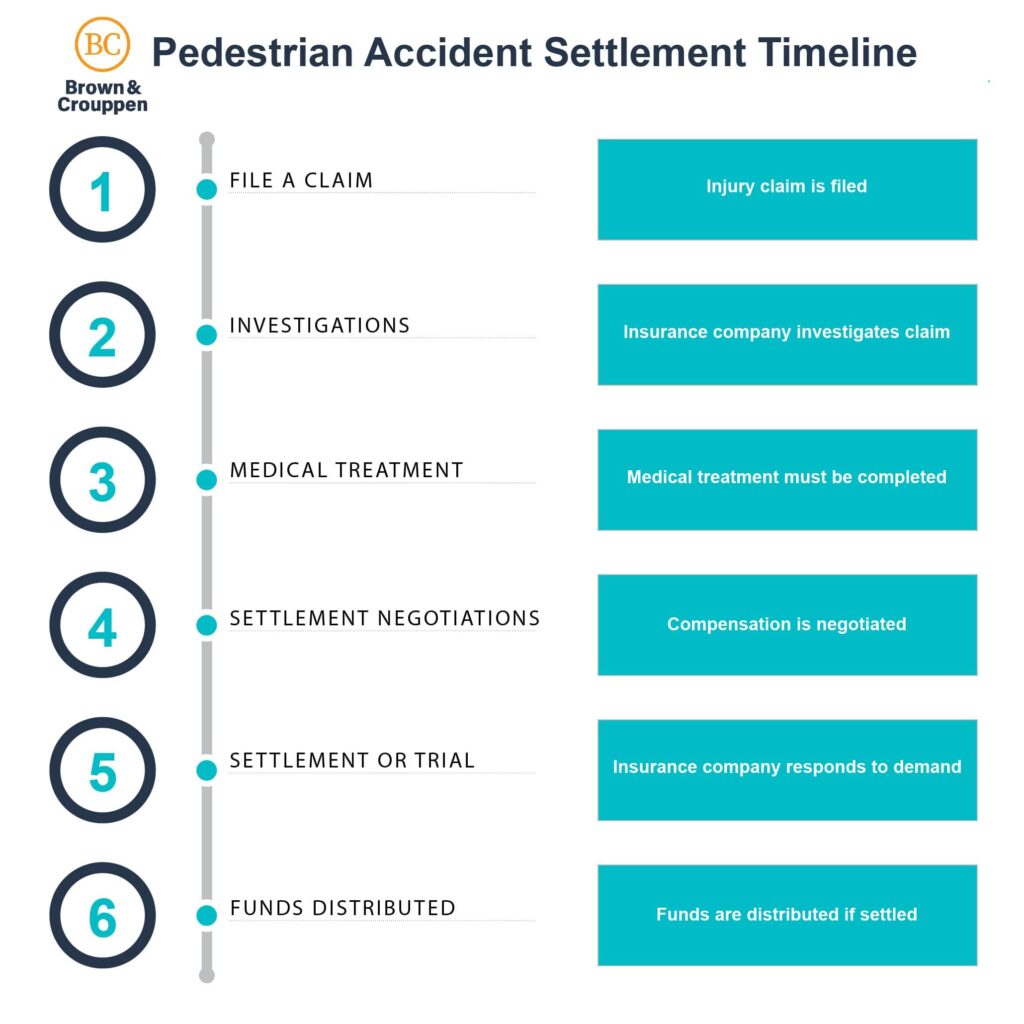
- Claim Filing – The injured pedestrian files a claim for compensation with the insurance company of the driver or any responsible party involved in the accident. Many times “pedestrian accident claim” and ” pedestrian lawsuit” are used interchangeably, but they’re not the same. A claim is submitted to an insurance company, while a lawsuit is filed in court if necessary, following formal rules of discovery and evidence.
- Investigation – Both parties investigate the circumstances of the accident and the extent of damages. Pedestrian accident attorneys and their teams collect evidence, including police reports, witness statements, medical records, and photos or footage from the accident scene. This evidence helps build a strong case for the pedestrian’s injury claim.
- Medical Treatment – The focus of a pedestrian accident claim is the injury itself. Depending on the severity, the injured party may need medical treatment that could last a few weeks or extend over several months.
- Demand and Negotiation – After gathering all necessary evidence, a personal injury lawyer will send a demand letter to the insurance company of the party responsible for the accident. This letter outlines the compensation sought, and the parties engage in negotiations to reach a fair settlement.
- Settlement Agreement – If both sides agree on terms, the case is settled. Attorneys draft legal documents and releases that detail the terms of the settlement. Once these documents are signed and witnessed, the settlement funds are prepared for distribution.
- Disbursement – The settlement funds are then disbursed. This includes payments to the injured party, attorneys, and any lien holders, such as medical providers who treated injuries related to the accident.
Factors That Affect the Length of a Pedestrian Accident Case
1. Length of Medical Treatment
To get the full value of a pedestrian accident claim, you need to reach maximum medical improvement, or something close to that, before settling your case.
Maximum medical improvement doesn’t mean that you are back to the health that you had prior to the crash, but rather that you are as good as you are going to get health-wise from a reasonable medical standpoint. This may be after surgery plus weeks or months of physical therapy or multiple consultations. It means you have moved from active treatment for your injuries to no treatment or only conservative treatment (i.e., follow-ups with your doctors every six months to a year, depending on what your doctor recommends). Reaching maximum medical improvement gives the injured party and the insurance adjuster a full picture of what your limitations are expected to be in at least the near future and possibly in the years to come. It isn’t just the injury that determines the value of a claim, but it’s also the symptoms and limitations that result from the injury.
2. Collecting Evidence
Once treatment has been completed, you’ll need to collect all the medical bills and records to establish the cost of treatment and provide evidence of symptoms and limitations.
As the injured party making a claim, you have the burden of proof not only that the other party is at fault for your injuries, but also that you suffered the actual injuries, that the incident caused the injuries, and that you experience symptoms and limitations. The insurance company will not take you at your word. They want to pay as little as possible for your claim. You can prove your injuries and limitations by providing medical bills and records as well as information from your employer about lost wages (or tax returns if you are self-employed).
3. Negotiations & Litigation
Once you have all the information to make your initial demand and get the demand letter sent, you must give the insurance company a reasonable period to review the records and bills. This will allow for them to make a liability determination (if one has not already been made) and to determine how much they are willing to offer on the pedestrian accident claim. This period depends on the complexity of the case facts as well as the complexity of the injuries. A crash that occurs in a crosswalk where the pedestrian had the right of way and it’s recorded on video may only require a month to review the demand package whereas a crash that occurs outside of a crosswalk with uncertain liability and catastrophic injuries may require up to 90 days to decide (even then, the insurance company may request more time). Additionally, the insurance company may request additional information to make their decision in your pedestrian accident case such as prior medical records. However, not all requests for additional information by the insurance company are reasonable and may be a delay tactic. It’s up to your attorney to weigh whether to provide this additional information if they believe it will move the case along.
Usually, settlements are achieved through the settlement negotiation process, but occasionally the injury attorney will recommend filing a lawsuit. Lawsuits are more common in pedestrian accident cases than in many other clear-cut car crashes because often the adjusters in pedestrian accident cases will deny that their insured is at fault for the crash. They may allege that the pedestrian shouldn’t have been where they were at the time of the crash. While lawsuits are time consuming and a tiring process, it may be required to obtain a just result. Though most cases settle, even in litigation, many do so in the days and weeks immediately before their trial date, which could be years out from the date of filing the suit.
4. Paying Outstanding Medical Bills
After you’ve finished treatment and gone through negotiations (or potentially litigation), you will finally come to an agreement with the insurance company and agree to a settlement amount. Your attorney has told you what you can expect to receive out of the settlement after the attorney fees, case expenses, medical bills, and potentially health insurance or loan amounts are paid back. Still, it feels like it’s taking too long to get your check. Why?
Many medical or other insurance providers have a legal right to repayment. Some medical providers may have filed a lien on your case, meaning they have deferred payment in exchange for the guarantee that they will be paid out of the settlement. Additionally, health insurance providers, including Medicare, Medicaid, Tricare, and other government-sponsored health insurance, have a right to repayment on healthcare costs associated with your injury treatment (employer-sponsored health insurance provider may have a right to repayment; talk to your attorney to determine whether yours has a right to be paid back). Your attorney will be obtaining the final payoff amounts and likely negotiating the bills down before they pay out the settlement.
Additionally, if you received policy limits offered in your case, your attorney will likely be investigating whether the at- fault defendant has any additional insurance coverage by requesting their insurance declaration page, and, in some circumstances, an affidavit of no other insurance.
Other Legal Considerations for Pedestrian Accident Claims
- Statute of Limitations: Each jurisdiction has a statute of limitations that establishes a specific time frame within which a legal claim must be filed. In pedestrian accident cases, the statute of limitations varies from state to state and can range from one to several years. In the state of Missouri, the statute of limitations for car accidents (including individuals who were hit by a car) is 5 years from the date of the accident. Failing to file a claim within the stipulated time can result in the loss of the right to seek compensation. It is crucial to consult with an attorney promptly to ensure compliance with the applicable statute of limitations.
- Court Proceedings & Trial: If a settlement cannot be reached through negotiations or mediation, the pedestrian accident case may proceed to court. Litigation adds significant time to the overall legal process due to court schedules, hearings, and trial preparations. For example, the duration of court proceedings can be unpredictable, depending on the court’s caseload and other variables.
Get Help From a Pedestrian Accident Attorney at Brown & Crouppen Law Firm
If you or a loved one were injured as a pedestrian due to someone else’s negligent acts or omissions, you may be eligible to recover financial compensation for damages.
Getting started is easy. Request a free case evaluation online or get help from our legal team by calling us at 888-795-0694 for a free consultation. And remember, there’s no upfront cost to you — if you don’t get paid, we don’t get paid. Our Kansas City and St. Louis pedestrian accident attorneys work on a contingency fee basis.

